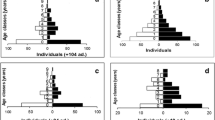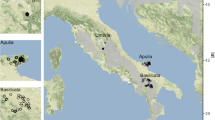Abstract
Lethal control of stock-raiding predators is generally assumed to have fewer consequences for the species’ population dynamics if it involves males only. However, very little data are available that assess whether shot “problem” animals indeed are essentially males. In this study, we used two independent genetic methods (four X-chromosomal polymorphic microsatellite loci and the sex-specific ZFXY marker) validated against known-sex samples to determine, from skin samples collected over a 6-year period, the sex of 59 leopards (Panthera pardus) shot by farmers in Botswana. We found that out of 53 leopards that could be sexed genetically, 21 were females (39.6 %); males were thus not significantly more often shot than females. Comparing the genetically determined sex of shot leopards to that reported by farmers showed that 58.3 % were mistaken for the opposite sex. Our genetic study revealed that more females than presumed are hunted in response to alleged livestock predation. With females frequently misidentified as males, the current practice of shooting “problem” animals is likely to negatively affect the population dynamics of leopards. These genetic data may be used to guide the development of a revised management policy for large-carnivore hunting. Importantly, models of sustainable harvest need to include female off-take as a parameter.

Similar content being viewed by others
References
Balme GA, Slotow R, Hunter LTB (2010a) Edge effects and the impact of non-protected areas in carnivore conservation: leopards in the Phinda–Mkhuze Complex, South Africa. Anim Conserv 13:315–323
Balme GA, Hunter LTB, Goodman P, Ferguson H, Craigie J, Slotow R (2010b) An adaptive management approach to trophy hunting of leopards (Panthera pardus): a case study from KwaZulu-Natal, South Africa. In: Macdonald DW, Loveridge AJ (eds) Biology and conservation of wild felids. Oxford University Press, Oxford, pp 341–352
Balme GA, Hunter L, Braczkowski AR (2012) Applicability of age-based hunting regulations for African leopards. PLoS ONE 7:e35209
Barnhurst D (1986) Vulnerability of cougars to hunting. Dissertation, Utah State University, Logan
Caro TM, Young CR, Cauldwell AE, Brown DDE (2009) Animal breeding systems and big game hunting: models and application. Biol Conserv 142:909–929
Daly B, Power J, Camacho G, Traylor-Holzer K, Barber S, Catterall S, Fletcher P, Martins Q, Martins N, Owen C, Thal T, Friedmann Y (2005) Leopard (Panthera pardus) population and habitat viability assessment. Endangered Wildlife Trust, Johannesburg
Dutta T, Sharma S, Maldonado JE, Wood TC, Seidensticker J (2012) A reliable method for individual identification and gender determination of wild leopards (Panthera pardus fusca) using non-invasive samples. Conserv Genet Resour 4:665–667
Inskip C, Zimmermann A (2009) Human–felid conflict: a review of patterns and priorities worldwide. Oryx 43:18–34
Loveridge AJ, Packer C, Dutton A (2009) Science and the recreational hunting of lions. In: Dickson B, Hutton J, Adams WM (eds) Recreational hunting, conservation and rural livelihoods: science and practice. Blackwell Publishing, Oxford, pp 108–124
Loveridge AJ, Wang SW, Frank LG, Seidensticker J (2010) People and wild felids: conservation of cats and management of conflicts. In: Macdonald DW, Loveridge AJ (eds) Biology and conservation of wild felids. Oxford University Press, Oxford, pp 161–195
Menotti-Raymond M, David VA, Lyons LA, Schäffer AA, Tomlin JF, Hutton MK, O’Brien SJ (1999) A genetic linkage map of microsatellites in the domestic cat (Felis catus). Genomics 57:9–23
Milner JM, Nilsen EB, Andreassen HP (2007) Demographic side effects of selective hunting in ungulates and carnivores. Conserv Biol 21:36–47
Müllenbach R, Lagoda PJ, Welter C (1989) An efficient salt-chloroform extraction of DNA from blood and tissues. Trends Genet 5:391
Packer C, Kosmala M, Cooley H, Brink H, Pintea L, Garshelis D, Purchase G, Strauss M, Swanson A, Balme G, Hunter L, Nowell K (2009) Sport hunting, predator control and conservation of large carnivores. PLoS ONE 4:e5941
Packer C, Brink H, Kissui BM, Maliti H, Kushnir H, Caro T (2011) Effects of trophy hunting on lion and leopard populations in Tanzania. Conserv Biol 25:142–153
Pecon Slattery J, O’Brien SJ (1998) Patterns of Y and X chromosome DNA sequence divergence during the Felidae radiation. Genetics 148:1245–1255
Perez I, Geffen E, Mokady O (2006) Critically Endangered Arabian leopards Panthera pardus nimr in Israel: estimating population parameters using molecular scatology. Oryx 40:295–301
Pilgrim KL, McKelvey KS, Riddle AE, Schwartz MK (2005) Felid sex identification based on noninvasive genetic samples. Mol Ecol Notes 5:60–61
Rodgers TW, Janečka JE (2013) Applications and techniques for non-invasive faecal genetics research in felid conservation. Eur J Wildl Res 59:1–16
Schiess-Meier M, Ramsauer S, Gabanapelo T, König B (2007) Livestock predation—insights from problem animal control registers in Botswana. J Wildl Manag 71:1267–1274
Spong G, Hellborg L, Creel S (2000) Sex ratio of leopards taken in trophy hunting: genetic data from Tanzania. Conserv Genet 1:169–171
Treves A (2009) Hunting for large carnivore conservation. J Appl Ecol 46:1350–1356
Weilenmann M, Gusset M, Mills DR, Gabanapelo T, Schiess-Meier M (2010) Is translocation of stock-raiding leopards into a protected area with resident conspecifics an effective management tool? Wildl Res 37:702–707
Acknowledgments
We thank Botswana’s Department of Wildlife and National Parks for permission to conduct the study and for continuing support. David Mills kindly helped with sample collection. Samples were exported and imported under CITES permits issued to the University of Zurich by Botswana’s Department of Wildlife and National Parks and the Swiss Federal Veterinary Office, respectively, as well as a veterinary permit issued by Botswana’s National Veterinary Laboratory. The study was funded by the PSP Publishing Foundation, the Messerli Foundation, the African Cats & Conservation Foundation and BGS Architekten. The manuscript benefitted from comments provided by Rus Hoelzel and two anonymous referees.
Author information
Authors and Affiliations
Corresponding author
Rights and permissions
About this article
Cite this article
Kerth, G., Gusset, M., Garbely, J. et al. Genetic sexing of stock-raiding leopards: not only males to blame. Conservation Genet Resour 5, 1101–1105 (2013). https://doi.org/10.1007/s12686-013-9979-4
Received:
Accepted:
Published:
Issue Date:
DOI: https://doi.org/10.1007/s12686-013-9979-4




